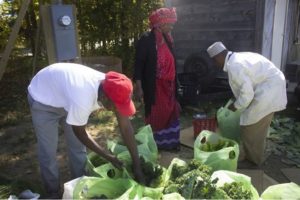By Nick Fouriezos, ozy
The husband and wife work together on their farm plot in Maine: She cuts cabbages, and he places them in green grocery bags, mixing them with carrots, broccoli and other vegetables. From a distance, the pair look like any other Northeasterners taking in a late harvest and heading to the farmers market. But up close, his austere white tunic and taqiyah stand out — as does her brilliant red headscarf and Africana skirt. Jabril Abid and Khadija Ali are Somali Bantu immigrants, just two of the 7,500 refugees who have come here in the past 16 years, helping revive the once-stumbling New England mill town of Lewiston.

Their efforts are just one peek into the way farming advocates across Maine are trying to attract fresh talent that is willing to shoulder the risk of a shrinking agricultural industry. In nearby Lisbon, the nonprofit Cultivating Community operates an incubating farm for “new Americans,” training them on the particulars of the Northeast’s finicky ecosystem. The Maine Organic Farmers and Gardeners Association (MOFGA) operates a journeyperson program, which apprentices 50 new farmers each year. Legal groups such as Land for Good, based in Keene, New Hampshire, and the Maine Farmland Trust are working with Northeastern communities to negotiate contracts that keep land in farmers’ hands — rather than selling them off to the next Super Target.
Their work has added urgency these days. Across New England, a third of farmers plan to exit the industry in the next decade. But who will replace them is still unclear. After all, nine in 10 of those farmers aren’t working with a younger person beside them, which makes a clear path to succession hazy at best, according to a survey published last year by Land for Good. So far, farming advocates are confident they can grapple with the issue through creative means but acknowledge that it’s a problem looming on the horizon — and one that, if they aren’t careful, may just catch up on them. “I’m incredibly worried here,” says MOFGA educational programs director Daniel MacPhee.
The difficulties they face are mounting. More farms are passing from owner-operators to family trusts. “What are the implications for land that stays in farming that isn’t owned or controlled by the people who are farming it?” asks Jim Hafner, executive director of Land for Good. Some studies show increased foreign purchases of farmland, although only by a few percentage points. “Is it a worrying trend? Maybe,” Hafner says. The greatest risk, however, is the disproportionate number of older farmers working the land: One-third of cropland is managed by people 65 or older, while those under 45 only operate about 12 percent of it, Hafner says.
Transitioning to younger ownership is often difficult. For instance, many older farmers work in dairy, which has high upfront costs. They may have trouble finding buyers in the next generation, which typically wants a lower-cost entry point or to work in emerging agricultural sectors, such as diversified vegetable growing sold through direct-to-consumer models. “If there isn’t a way to pass that land on, or for younger farmers to access it, during that transition is when a farm is most vulnerable,” Hafner says.
In Maine small-scale farms predominate, catering to fairs, festivals and individual buyers. And yet “we’re one of the only states where the average age of farmers is decreasing,” MacPhee says. At the Common Ground fair this September, which drew thousands of farmers to rural central Maine, Land for Good held a seminar on farm succession. Meanwhile, MOFGA stood by ready to answer questions about its apprenticeship program: It began in 1999, and a remarkable 92 percent of its graduates are still farming, the vast majority in Maine. The program costs about $6,000 per farmer — but that translates into land that stays in agriculture, food produced for the community and more people hired to work farms. “When you look at the broader effects,” says MacPhee, “it seems like a very small investment.”
Immigrants like Abid and Ali are also becoming a key part of the state’s — and nation’s — investment in farming. That’s an advantage that Maine, which has the third highest Somali resettlement rate in the country, has over many of its northern neighbors. Last October, Lewiston received a nearly $400,000 grant from the U.S. Department of Agriculture to help Somali Bantu farmers build capacity and expand community access to fresh food.
Last December four new American farmers bought a 30-acre cooperative farm, New Roots Cooperative, with the goal of converting what was once a dairy pasture into a field growing dozens of kinds of vegetables. The former refugees, fleeing civil war in Somalia, had spent the past decade farming with Cultivating Community. For many of these newcomers, working the land is a relatively natural transition, says Mohammed Sheikh, a high school senior and the son of Abid and Ali: “Most of them, especially if they are older and don’t speak English, can’t go into the workforce, and they don’t want to be on welfare forever.”
There were growing pangs, of course. In Somalia, “there’s no such thing as kale and eggplant,” Sheikh says. “We had mangoes, coconuts — the only one that wasn’t different was corn.” But these immigrants have made themselves at home, and their children, who often serve as translators, could very well follow in their footsteps. “Culturally, if your parents are farmers, we expect the next generation to be farmers. Every year, there are more people coming in, wanting our vegetables,” Sheikh says. “Business has been good so far. Everything is new for them. But they’re proud of it.”
Source: OZ


